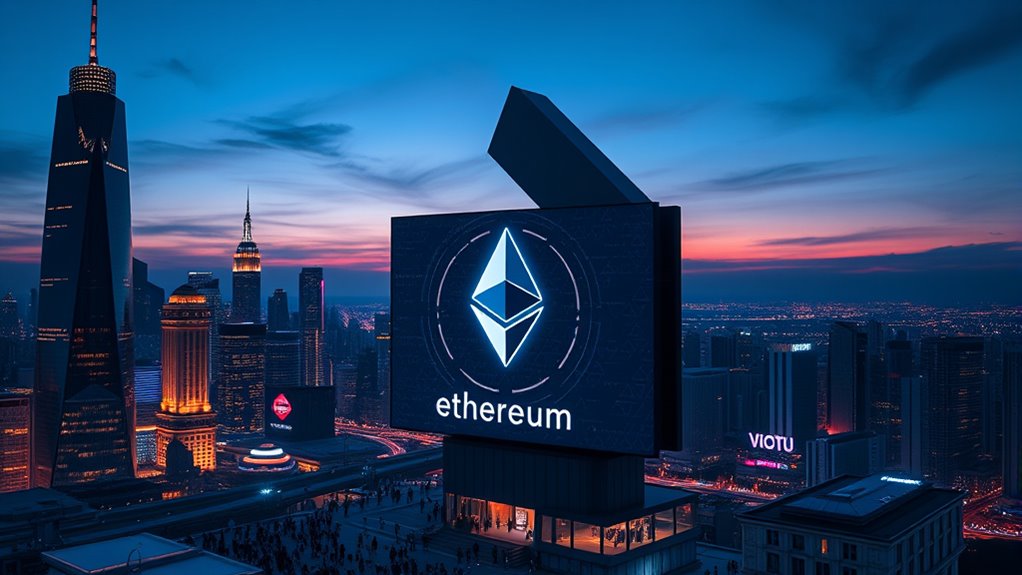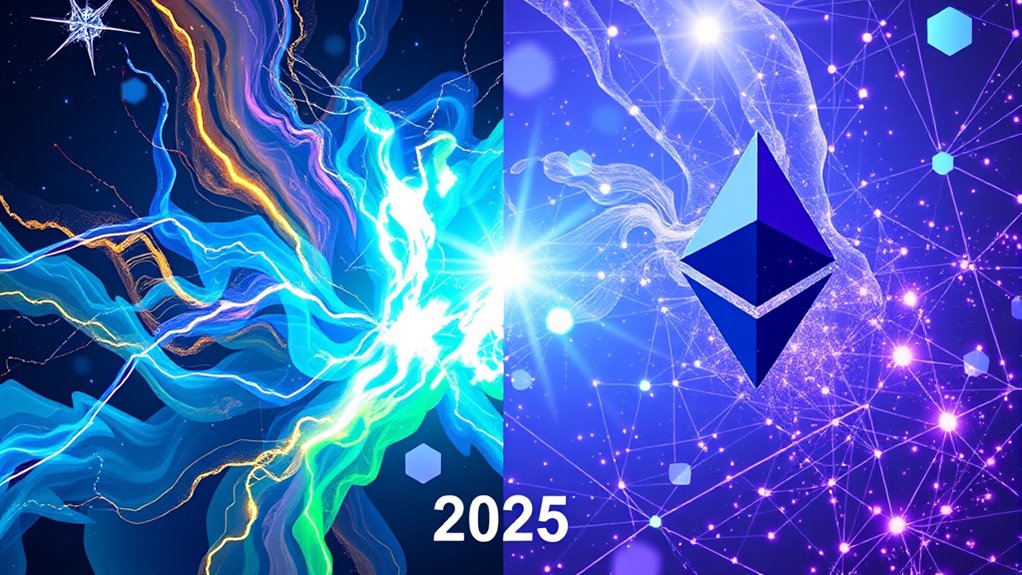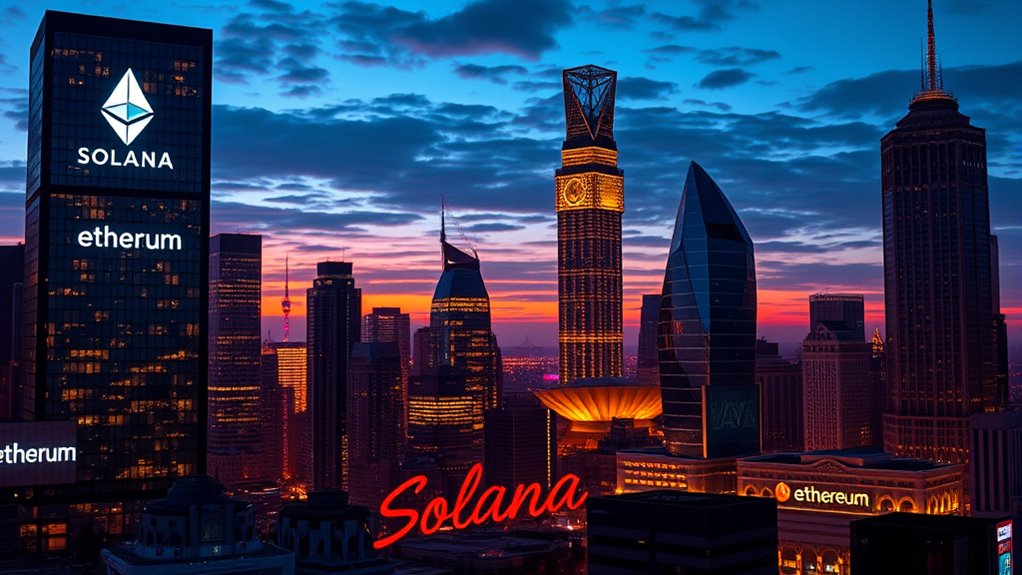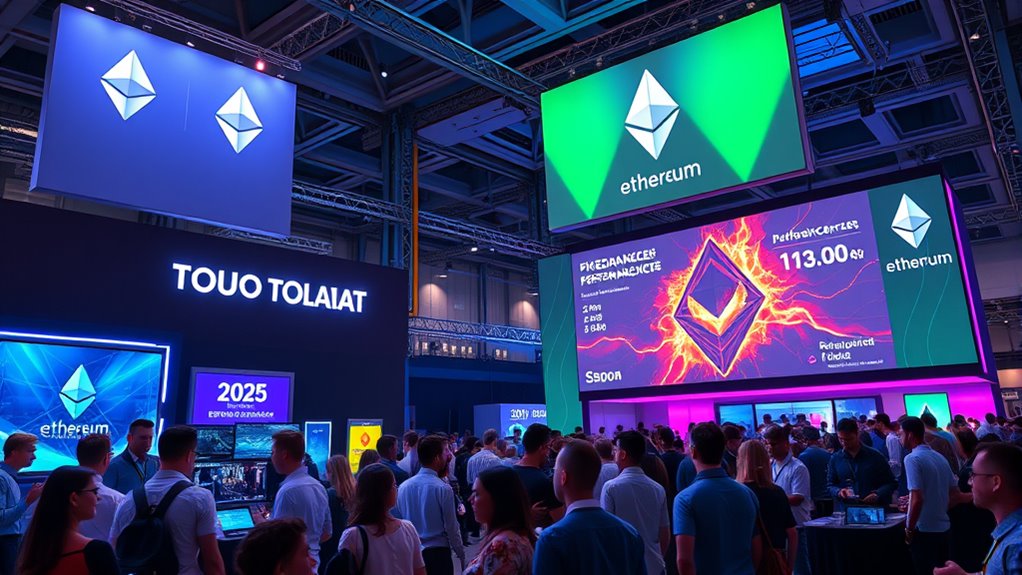In 2025, you're faced with a choice between Solana and Ethereum for blockchain supremacy. Solana boasts lightning-fast speeds of over 4,000 transactions per second and minimal fees around $0.00025. In contrast, Ethereum's established ecosystem and over 1 million developers provide a solid foundation. While Solana's upcoming Firedancer upgrade may enhance its performance, Ethereum continues to attract institutional interest. Explore how these factors shape the future landscape of blockchain technology and investment opportunities.
Key Takeaways
- Solana's upcoming Firedancer upgrade may boost its processing speed up to 1 million tps, enhancing its competitive edge against Ethereum.
- Ethereum's established ecosystem and over 1 million developers provide a robust foundation for growth, despite lower transaction speeds.
- Solana's average transaction fee is $0.00025, significantly lower than Ethereum's median fees of $0.05 to $10, making it cost-effective.
- Both blockchains face investment risks: Solana's centralization concerns and Ethereum's regulatory scrutiny could impact their market positions.
- Analysts predict Solana's price could reach $250-$400, while Ethereum's forecast ranges from $4,000 to $4,500 by 2025, highlighting their growth potential.
Overview of Solana

When you immerse yourself in Solana, you'll find a blockchain platform that stands out for its innovative Proof of History (PoH) consensus mechanism. This unique approach allows Solana to achieve impressive transaction speeds of over 4,000 transactions per second, making it one of the fastest options available. Low fees are another significant advantage; you can expect to pay around $0.00025 per transaction. As of February 2025, Solana boasts a market capitalization of approximately $103.74 billion, reflecting its widespread adoption and popularity. The upcoming Firedancer upgrade is set to enhance its network capabilities even further, with potential processing speeds reaching up to 1 million transactions per second. Solana truly combines speed and affordability in the blockchain space. Additionally, its energy-efficient technology is drawing attention for promoting sustainable practices in blockchain operations, as many projects are increasingly focused on environmental responsibility.
Overview of Ethereum

Ethereum, the pioneering blockchain platform launched in 2015, has set the standard for smart contracts and decentralized applications. With a market capitalization of over $391 billion, Ethereum supports a thriving ecosystem of decentralized finance (DeFi) protocols and non-fungible tokens (NFTs). As of 2023, it boasts 100 million funded addresses, showcasing its vast user base. Ethereum's Proof-of-Stake consensus enhances security but currently processes only about 15 to 30 transactions per second, raising questions about its competitive edge. The decreasing trend in fees, with January 2025 revenue at $109.1 million, adds to this concern. Additionally, new Bitcoin holders controlling 50% of the supply indicates a strong demand that could impact Ethereum's market dynamics. To navigate potential market fluctuations, many investors are considering risk management strategies to protect their assets.
| Feature | Ethereum | Competitors |
|---|---|---|
| Market Cap | $391 Billion | Varies |
| Transactions per Second | 15-30 | 65,000 (Solana) |
| Funded Addresses | 100 Million | Varies |
Performance Comparison: Speed and Scalability

While Ethereum has established itself as a foundational player in the blockchain space, its performance regarding speed and scalability raises important questions.
Solana dramatically outshines Ethereum with a transaction speed of over 4,000 transactions per second (tps), compared to Ethereum's 15 to 30 tps. This performance comparison highlights Solana's superior capabilities, especially for applications requiring rapid transactions. Additionally, market volatility can significantly impact the performance of various cryptocurrencies, making speed and scalability crucial for developers and users alike.
Furthermore, Solana boasts incredibly low transaction costs at approximately $0.00025, while Ethereum's median gas fees can soar from $0.05 to $10.
Although Ethereum's scaling efforts through Layer-2 solutions aim to alleviate congestion, they still lag behind Solana's current performance.
With the upcoming Firedancer upgrade, Solana could potentially handle up to 1 million tps, further enhancing its scalability. Furthermore, investors looking to diversify their portfolios may consider integrating Bitcoin in retirement accounts, as it provides tax-efficient growth alongside traditional cryptocurrencies like Ethereum.
Transaction Fees: Solana vs. Ethereum

Here are some key points to reflect upon:
- Average Transaction Fee: Solana's average transaction fee is just $0.00025, while Ethereum's median gas fee fluctuates between $0.05 and $10, depending on congestion. Additionally, the potential for tax-deferred growth in investments may drive interest in platforms with lower fees.
- Transaction Volume: In January 2025, Solana generated nearly $250 million in fees, surpassing Ethereum's $140 million, showcasing its increasing popularity.
- Processing Power: Solana handles over 4,000 transactions per second compared to Ethereum's 15, directly contributing to its lower fees. This shift in transaction fees highlights how Solana is becoming the go-to platform for users seeking lower costs and faster processing in the Solana vs Ethereum debate. Additionally, factors such as interest rates can influence the investment attractiveness of these blockchain platforms as they continue to evolve.
Market Capitalization and Growth Trends

As you explore the current market valuations, you'll notice a stark contrast between Ethereum and Solana.
Historically, Ethereum's market cap has overshadowed Solana's, but recent growth trends hint at a significant shift. This shift can be attributed to automation's role in enhancing the efficiency and speed of blockchain operations, providing a competitive edge to platforms like Solana.
Understanding these dynamics will help you grasp the evolving landscape of these two cryptocurrencies. Additionally, considering the importance of investment diversification can provide insights into how these cryptocurrencies fit within broader financial strategies.
Current Market Valuations
In early 2025, Ethereum's market capitalization stands at about $391.09 billion, making it the second-largest cryptocurrency, whereas Solana's market cap has surged to around $103.74 billion, reflecting impressive growth.
The current market valuations illustrate a notable shift in the crypto market:
- Ethereum's market cap has decreased from over 8 times larger than Solana to just 3 times larger in a year.
- Solana's price skyrocketed to an all-time high of $293.91 in January 2025, showcasing its potential.
- Analysts predict Solana's price could reach between $250 and $400, while Ethereum's forecasts hover around $4,000 to $4,500. This volatile market environment necessitates that investors remain vigilant and adapt their strategies accordingly.
These trends indicate a competitive landscape, with Solana making significant strides in the market. Additionally, investors should consider risk management strategies to navigate the inherent volatility of cryptocurrency investments.
Historical Growth Comparisons
Historical growth comparisons between Solana and Ethereum reveal a captivating shift in market dynamics.
As of early 2025, Ethereum's market capitalization is around $391.09 billion, while Solana's stands at $103.74 billion. Although there's still a significant gap, it's narrowing—down from over eight times in 2023 to three times in 2024.
Solana's price has surged more than 2,000% since its 2022 low, highlighting its rapid growth and increasing investor interest, especially compared to Ethereum's more stable trajectory. This growth trend can be likened to how Gold IRAs have gained traction as alternative investment options amid market fluctuations.
Intriguingly, while Ethereum leads in total value locked in DeFi, Solana's lower transaction fees and growing user base are challenging Ethereum's dominance. This evolution indicates a potential shift in the blockchain landscape you won't want to overlook, especially as investment strategies continue to evolve in response to these market changes.
Ecosystem and Developer Engagement

While Solana has surged ahead in attracting new developers, Ethereum still holds a strong lead with its well-established ecosystem.
Here's what you should know about developer engagement on both platforms:
- Developer Community: Ethereum boasts over 1 million developers, fostering collaboration and innovation within its ecosystem, especially for dApps and DeFi protocols. This extensive network enhances the platform's retirement savings plan through innovative financial applications.
- Language Accessibility: Ethereum's Solidity is widely taught, making it easier for new developers to jump in, unlike Solana's Rust, which may limit accessibility.
- Token Launches: Solana has become the go-to for new tokens, especially in the meme coin market, reflecting its thriving ecosystem and appeal for those looking to create unique projects.
- Investment Strategies: Engaging with both ecosystems can lead to diverse investment strategies that minimize risk and enhance potential returns.
In the battle for blockchain supremacy, both ecosystems present unique advantages and challenges.
NFTs on Solana and Ethereum

As the NFT market continues to evolve, the rivalry between Solana and Ethereum showcases distinct advantages tailored to different creators and collectors.
Solana offers a user-friendly experience with lightning-fast transaction speeds exceeding 4,000 transactions per second and low transaction fees averaging just $0.00025. This attracts many looking to buy and sell NFTs without breaking the bank. Additionally, decentralized finance platforms on Solana are reshaping the traditional approach to asset management, enhancing the overall ecosystem for NFT transactions.
On the other hand, Ethereum remains the leading blockchain for NFTs, boasting an established ecosystem with platforms like OpenSea, although its gas fees can range from $0.05 to $10. While Solana shines in efficiency and cost, Ethereum's robust infrastructure and extensive developer community foster innovation, making both blockchains appealing based on your specific needs in the NFT space. Additionally, tropical fruits can be a great source of inspiration for unique NFT themes, reflecting the diversity found in creative digital art.
Strengths and Limitations of Solana

Solana stands out with its lightning-fast transaction speed, processing over 4,000 transactions per second. This makes it ideal for high-frequency trades. Moreover, the implementation of predictive modeling in blockchain applications could lead to enhanced decision-making and resource allocation.
However, you should be aware of its centralization concerns, as it operates with far fewer validators than Ethereum. This balance between speed and decentralization could impact your decision on which platform to choose. Additionally, the integration of AI tools in blockchain technology may enhance performance and efficiency, making platforms like Solana even more competitive in the future.
High Speed Transactions
When you compare transaction speeds, Solana stands out with its ability to process over 4,000 transactions per second (tps), far surpassing Ethereum's 15 tps. This efficiency not only enhances user experience but also keeps transaction fees low.
Here are some key points about Solana's high-speed transactions:
- Transaction Fees: Solana's average fee is just $0.00025, while Ethereum's median gas fee hovers around $0.05.
- Consensus Mechanism: Solana utilizes the Proof of History (PoH) consensus, which boosts both speed and scalability. This innovative approach is similar to how solar charge controllers optimize energy harvest in solar energy systems.
- Future Upgrades: The upcoming Firedancer upgrade aims to handle up to 1 million tps, solidifying Solana's edge over Ethereum in high-speed transactions. Additionally, investing in precious metals can serve as a hedge against inflation, further enhancing overall portfolio resilience.
Centralization Concerns
While the high transaction speeds and low fees of Solana attract many users, it's important to evaluate the centralization concerns that accompany its rapid adoption.
With only about 4,500 validators compared to Ethereum's over 1,000,000, Solana's network is more concentrated, raising questions about its decentralization. This concentration makes it vulnerable to potential control by a few entities.
Additionally, Solana has faced network outages, highlighting risks tied to its less distributed infrastructure. The use of Proof of History speeds up transaction validation but may jeopardize long-term security and decentralization as the ecosystem grows.
As you consider which blockchain to adopt, weigh these centralization concerns against the benefits Solana offers.
The Impact of Firedancer on Solana

As the Firedancer upgrade approaches in 2025, it promises to revolutionize Solana's capabilities by considerably increasing its transaction capacity.
With the potential to handle up to 1 million transactions per second, this upgrade builds on the existing Proof-of-History mechanism.
Here's how Firedancer will impact Solana:
- Enhanced Transaction Capacity: The upgrade considerably boosts throughput, allowing for seamless user experiences.
- Improved Network Stability: By addressing past outages, Firedancer enhances reliability, making the network more resilient.
- Attracting Developers: A more robust infrastructure will likely draw developers and users, strengthening Solana's competitive edge against Ethereum.
Future Outlook and Investment Potential

As you consider the future outlook for Solana and Ethereum, it's essential to analyze current market trends and the technological advancements both chains are pursuing.
With potential price growth on the horizon, you'll want to weigh the investment risks against the benefits each platform offers.
Understanding these dynamics will help you make informed decisions as 2025 approaches.
Market Trends Analysis
Given the rapid evolution of the cryptocurrency landscape, the market trends for Solana and Ethereum in 2025 reveal distinct paths and investment potentials.
- Solana's market cap has surged to approximately $103.74 billion, driven by its scalability, processing over 4,000 transactions per second with minimal transaction fees.
- Ethereum, with a market cap of $391.09 billion, continues to attract institutional interest, maintaining dominance in DeFi with $44.5 billion in total value locked.
- Solana's network anticipates the Firedancer upgrade, potentially boosting active users and developer engagement, while Ethereum's Pectra upgrade focuses on validator efficiency.
Investors should consider these factors in their market trends analysis to identify the best opportunities in 2025's competitive landscape.
Technological Advancements Ahead
With Solana poised to implement its Firedancer upgrade, the future of blockchain technology looks promising for investors and developers alike. This upgrade aims to enhance transaction speeds, allowing Solana to process up to 1 million transactions per second, making it an attractive platform for new projects.
Meanwhile, Ethereum's Pectra upgrade is set to improve validator efficiency and introduce AI-based smart contracts, keeping it competitive in the evolving landscape. As both platforms advance technologically, you'll find unique investment opportunities.
Analysts predict Solana's price could soar to between $250 and $400, while Ethereum's could range from $4,000 to $4,500 in 2025, making both blockchains worth considering for your portfolio amid these advancements.
Investment Risks Consideration
While both Solana and Ethereum are making strides with their technological upgrades, it's important to weigh the investment risks tied to each platform.
- Network Security: Solana's reliance on around 4,500 validators raises concerns about decentralization, which might impact investor confidence compared to Ethereum's over 1,000,000 validators.
- Market Volatility: The speculative nature of the meme coin market on Solana could lead to significant price swings, putting your investments at risk.
- Regulatory Scrutiny: Ethereum faces scaling challenges and regulatory pressures that could affect its position in the crypto space.
Considering these factors, while Solana is the better choice for potential high returns, a diversified investment approach between Ethereum and Solana may help mitigate these investment risks.
Frequently Asked Questions
Which Crypto Will Gain Most by 2025?
When considering which crypto will gain the most by 2025, you should look closely at market trends and growth potential.
Solana's impressive price surge and revenue generation signal strong interest and activity.
Conversely, Ethereum's established position in decentralized finance lends it stability and institutional confidence.
You'll want to weigh the risk versus reward carefully, as each offers unique advantages depending on your investment strategy and appetite for volatility.
Which Is Better, Solana or Ethereum?
When deciding which blockchain is better, you'll find both Solana and Ethereum have their strengths.
Solana boasts lightning-fast transaction speeds and incredibly low fees, making it appealing for users.
However, Ethereum's well-established ecosystem offers a wealth of decentralized applications and developer support.
If you're prioritizing speed and cost-effectiveness, you might lean toward Solana.
But if you value a robust platform with extensive resources, Ethereum could be your best bet.
Will Solana Do Good in 2025?
If you're considering Solana's potential in 2025, you'll see a landscape of growth, speed, and excitement.
With a market cap nearing $104 billion, you can expect significant returns as its price could soar between $250 and $400.
As the Firedancer upgrade strengthens network stability and with its impressive transaction speeds, you're looking at a platform that's ready for high-frequency trading and a swell of new users.
The future looks promising!
Can Solana Hit $1000?
Can Solana hit $1,000? It's certainly possible, given its impressive growth and upcoming Firedancer upgrade, which could boost network stability and attract more investors.
However, you should consider the risks, like its reliance on a small number of validators and the volatile nature of the meme coin market.
While estimates suggest high potential, keep an eye on market trends and developments to gauge if that ambitious target is achievable.
Conclusion
As we stand on the precipice of 2025, the battle between Solana and Ethereum resembles a thrilling race, with both blockchains vying for the crown. Solana dazzles with its blazing speed and low fees, while Ethereum's established ecosystem and innovation keep it in the spotlight. Ultimately, your choice might depend on what you value more: lightning-fast transactions or a robust community. Whichever path you choose, the blockchain landscape promises to be an exhilarating journey ahead!










